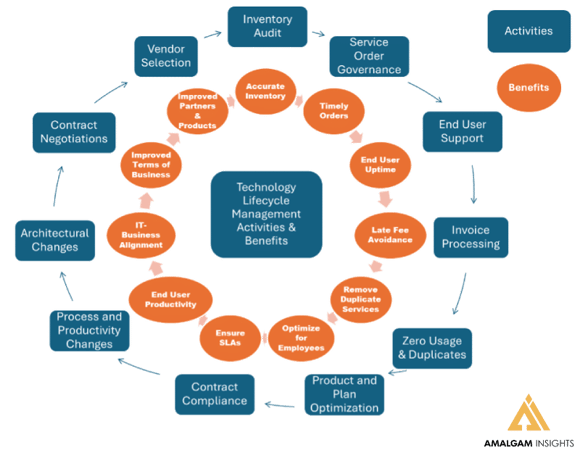Experienced IT professionals have probably run into the terms “TEM”, “Telecom Expense Management,” or “Technology Expense Management” at some point in their careers. As technology has evolved to take up between 4-5% of the average company’s budget, the need to manage IT costs has gained greater executive awareness over time. Amalgam Insights has seen wasted IT spend time and time again, to the point where we talk about the IT Rule of 30, a rule of thumb that states that any unmanaged IT category averages 30% in waste between unused resources, duplicate resources, and poorly planned spend.
However, for those who lack deep practical experience with TEM, it can be easy to look at one or two niche aspects of Technology Expense Management and think that they are handling the entire problem. For instance, Technology Expense Management includes the management of hardware, software, and sometimes even related utilities and contingent labor costs associated with IT and it is an evolutionary step from the market of Telecom Expense Management. When Telecom Expense Management was originally created several decades ago, telecom and network spend made up about half of all IT spend and it was the first major subscription-based spend category that IT had dealt with. This led to the development of complex spend management systems that combined call accounting, invoice management, contract management, rate plan and usage optimization, and related managed services such as technical support.
As IT evolved in the 21st century and software and cloud computing became larger subcategories of spend that were growing faster than telecom spend, telecom expense management changed over time to become technology expense management: a practice that allowed companies to fully track service and license inventories and service orders across all relevant IT vendors. As Total Cost of Ownership (TCO) became increasingly important as a measure of the true cost of operating technology, savvy IT organizations shifted to a lifecycle approach of managing costs that moved beyond simply paying bills and finding the biggest cost anomalies to a more strategic and holistic approach to governing, managing, and defining IT costs in context of the organizational and employee-centric needs for technology.
Amalgam Insights has used a version of the following graphic for the past seven years to show the basic activities and benefits that typically occur in a technology expense management or a technology lifecycle management practice.

As this figure shows, the full set of practices needed to manage technology costs include:
- Inventory management, to know what the organization has
- Service order management to track every interaction with each vendor
- End user support associated with technology services
- Bill processing and payment to avoid late fees and cross charge costs appropriately
- Zero usage and duplicate service optimization
- Rate plan, product, and service type optimization
- Contract compliance, audit, and enforcement
- Process, product, and productivity changes to reduce costs without reducing necessary functionalities
- Technology architecture reconsiderations based on corporate or organizational preferences
- Contract negotiations and renewals
- Vendor sourcing and migration
This combination of activities typically requires a combination of skills, including a technical understanding of each spend category, experience with vendor relations and billing formats, experience with accounts payable teams, and the ability to work in a cross-functional manner that may include working with IT, finance, accounting, procurement, and occasionally even with tax, legal, and security professionals.
And the reason for pursuing this set of capabilities is not simply to add complexity to an IT environment, but to achieve a more efficient and user-friendly IT environment while maintaining cost efficiencies. As stated before, the IT Rule of 30 has been a consistent challenge for IT over the past few decades and the low-hanging fruit associated with finding zero-usage circuits, cell phones, software licenses, and cloud computing instances is only a starting point to clean up technology expense environments.
In the next couple of blogs, I’ll start covering why TEM matters from an operational, financial, and strategic perspective especially as companies have increasingly become digital, service-based, and subscription-based and then provide my best tips and tricks from 20 years in the industry on how to execute on supporting and managing a world-class TEM environment without simply throwing an army of people at the problem.
If you are interested in learning more about modern telecom expense management and how it can benefit your company, talk to an expert today.
Contributed by Hyoun Park, CEO and Principal Analyst with Amalgam Insights




